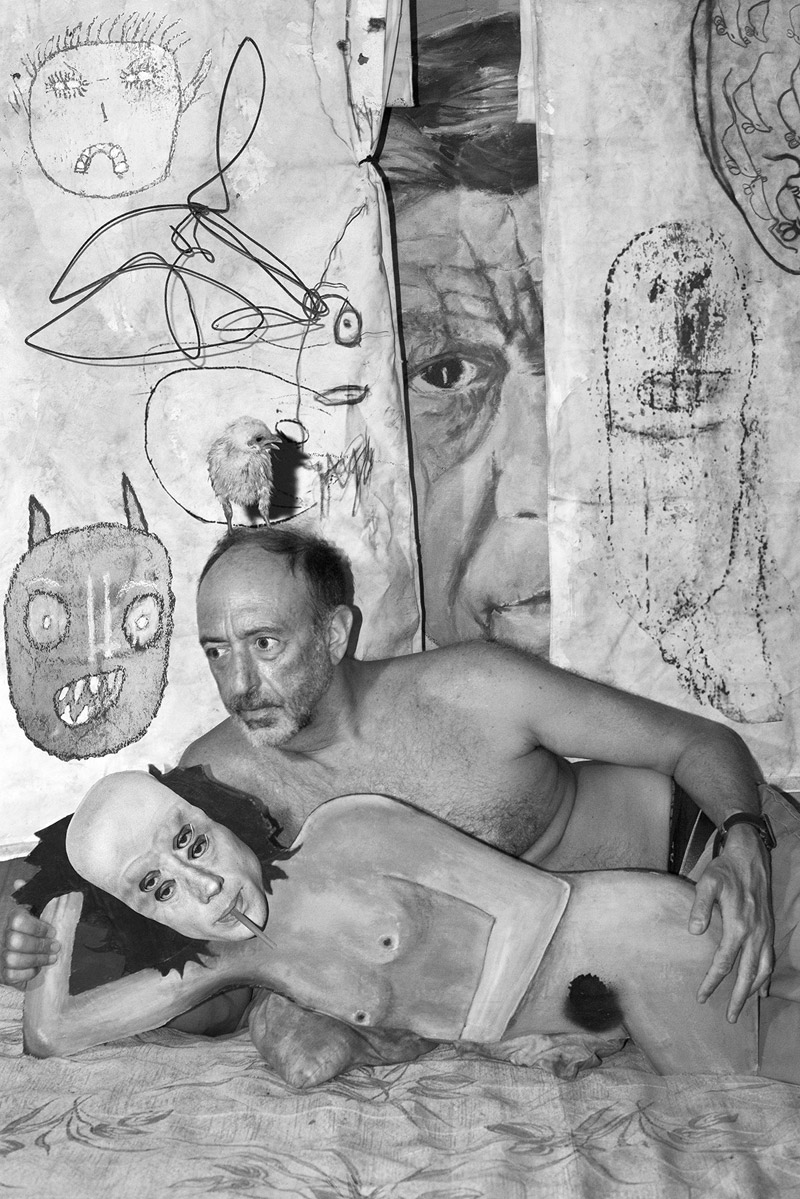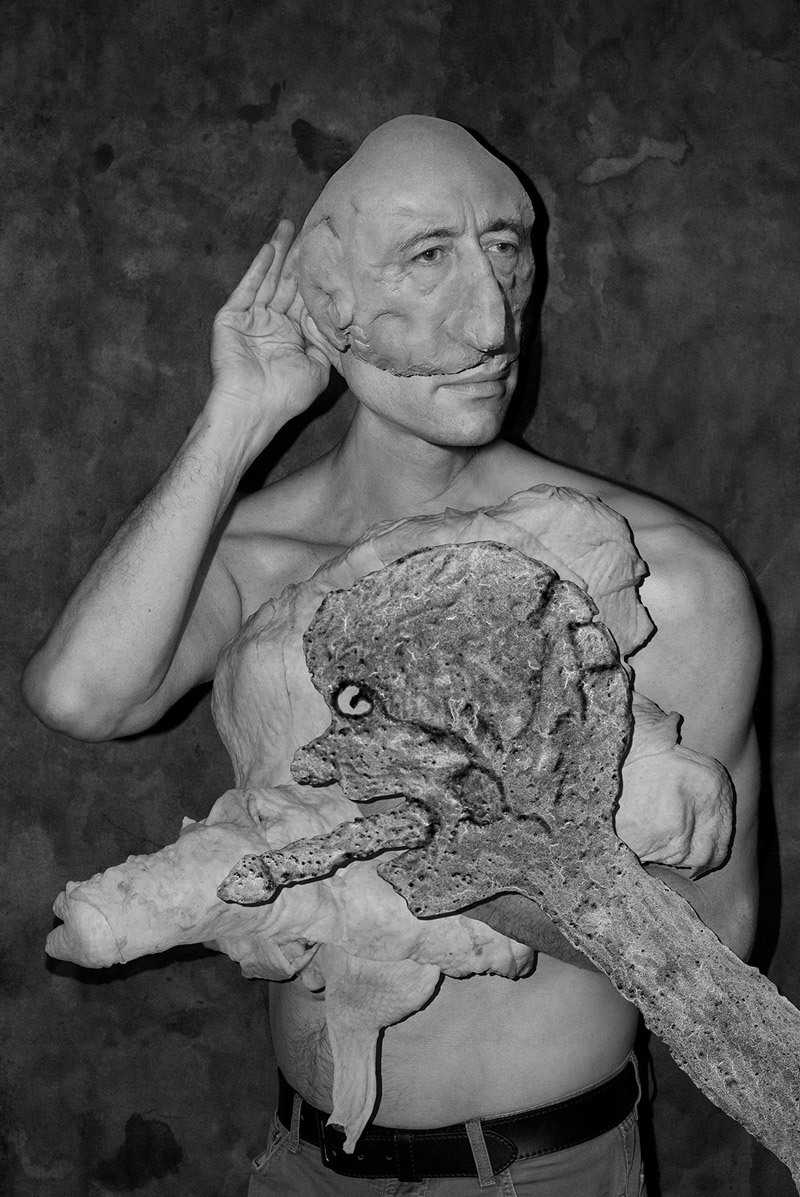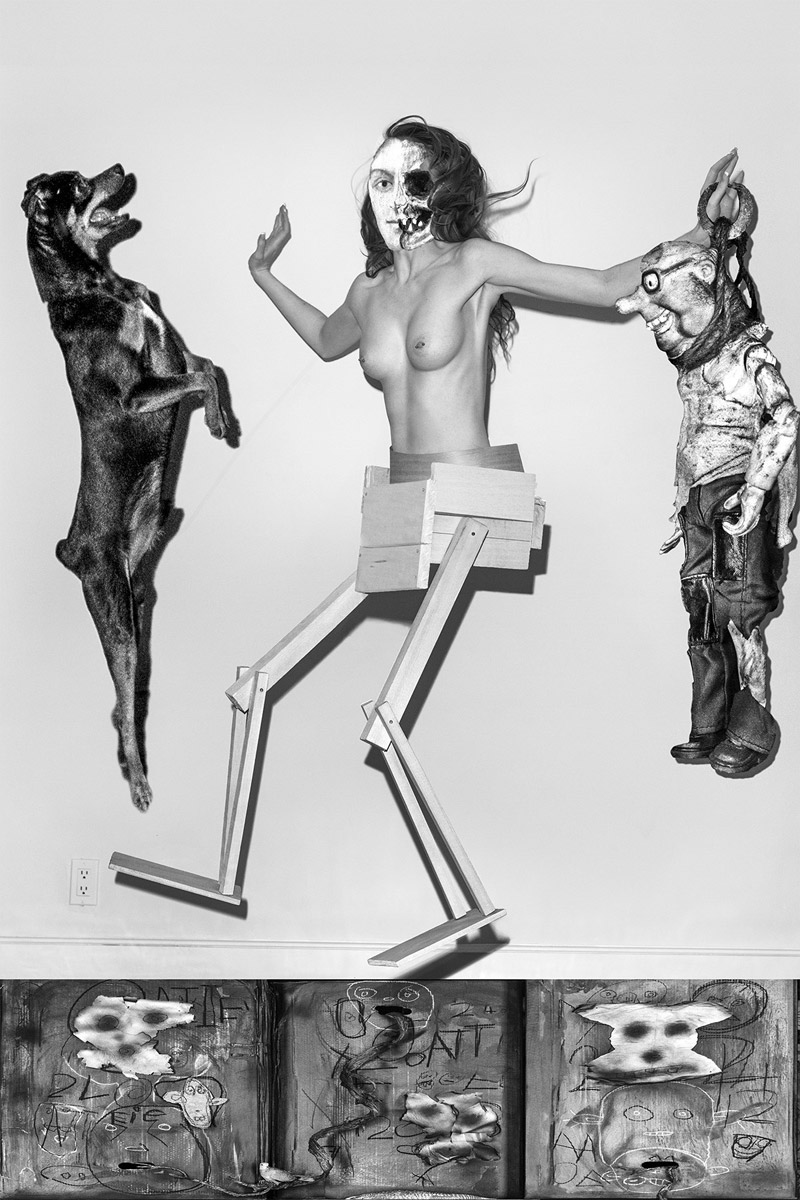This article originally appeared on dazeddigital.com
Roger Ballen and Asger Carlsen discuss a sinister new collaborative project that distorts the human body and pierces the psyche
By collaging bodies and deformed body parts, animals and cadavers, wooden prostheses and melting constructs, artists Roger Ballen and Asger Carlsen have created a series of twisted and hard to define artworks, resulting in the book titled No Joke. With an age difference of 23 years between the two, Ballen living in Johannesburg and Carlsen in China Town, NYC, it’s a collaboration of distance. But after being paired by Vice for a project in 2013, Roger and Asger discovered the similarities in their approach to their work. Sharing a deep interest in the dark corners of the psyche and the human condition, the two began exchanging ideas and digital files through email and Skype. This continued for several years. In each step the artworks are changed, expanded, enriched with new layers and oversubscribed, eventually turning into enigmatic photo collages that combine advanced digital image editing with analogue techniques of cutting, collaging and drawing. The creepy intimacy of the spaces they depict is hinted at by the elements that circumscribe them: there are no windows, and the walls are hung with fabrics, blinds, and pictures. Lateral wood panels and pieces of furniture or beds often add to the sense of confinement.
The universe that Ballen and Carlsen have created is sinister, grotesque, macabre, monstrous, and, depending on the strength of your stomach, disturbing and repulsive. This is a label both the artist’s work has been given countless times, but when asked about it, they argue that the disturbing effect is caused by traumas or anxiety within the viewer. The work has been a psychological journey for the artists themselves and their hope is to achieve a similar process within the viewer. Though Ballen and Carlsen hold onto that they don’t work directly with social or political issues, traces of comments on issues such as beauty standards, gender and body dysmorphia are apparent throughout the images.
We caught up with the artists to discuss why the book is called No Joke, how fiction can pierce deeper into people’s minds than reality and why we are all outsiders.
The book deals with the archetype of the outsider and you’ve also described yourselves as outsiders. In what way do you feel like outsiders?
Asger Carlsen: This outsider feeling goes back to my earlier projects. And I guess for me to make art or to do this project, was kind of a way to cope with different things from the past. And I guess I always had a feeling when I was growing up, that I wasn’t a part of the group in a way. I think that photography and making art has helped me get closer to a sane world, so to speak. And also to explain myself. Someone wrote on Wikipedia that my images were about a feeling of not belonging anywhere, which I can relate to.
Roger Ballen: I think the thing is that we all pretend that we belong. But at the end of the day, we are actually all outsiders. I think the outsider is a metaphor for the human condition. People pretend that they are in, but they really have no idea what “in” actually means. We are actually all kind of on the periphery of life in all sorts of ways, and not really understanding what our purpose is and what we are doing. So it’s a facade to believe that you are actually an insider. We are all born outsiders and we all die outsiders. It’s part of human absurdity. I mean what are you inside with? Does it mean that if you are an insider with people, that you are an insider with nature? And if you are an insider with the people at the country club, does it mean that you are an insider with yourself? So we are getting all screwed up with these words that are actually very general, but when you start to analyse them, they become meaningless. Just like many other words like beauty or happiness or sadness. The more you think of these words, the more they just fall apart.
Why do you both make psychologically based art?
Asger Carlsen: It’s like you have this awkward feeling, you don’t feel comfortable around people and for me, these images are getting rid of that feeling a little bit. It makes me more happy to have produced artwork.
Roger Ballen: I think Asger and I get a lot of pleasure out of what we do because we’re actually revealing and coming into contact with our inner being in one way or another. It’s quite gratifying to express that. I think that’s one of the really positive developments about doing art that has a psychological edge. If you’re just involved with making social comments, you might become quite depressed.
Because it’s too cynical?
Roger Ballen: It doesn’t lead anywhere. At least you can say at the end of the day, after you do a project, that you are a little bit closer to yourself.
Asger Carlsen: That is what we have in common, Roger and I. We want to make these images that are very open. They do have a lot of narrative, but the narrative doesn’t really reveal itself necessarily.
Roger Ballen: It’s a very visual narrative. It’s not something you can easily put a word around. They’re funny, they’re disturbing, they’re complex, they’re strange. I think that’s why they’re interesting. It’s a unique aesthetic both of us have created here. I haven’t seen anything like this in any photographs I’ve seen over the years. And I’ve seen a lot of photographs.
What’s your message with this book?
Asger Carlsen: I don’t think we really have a message.
Roger Ballen: If there was one message then the work wouldn’t have any value to it. It’s a pathway into the psyche and then people have to figure out how that passage affects them and why. They don’t even have to come up with words, we don’t have to come up with words for everything. That’s the neurosis of western society, people need to have have words for everything. Especially when they get anxious about something, then they really need to put a box around it, rather that just accept it on a more subconscious basis.
Asger Carlsen: It’s not like we have planned the stories. We have worked separately and sent material back and forth, but we haven’t talked about how the images should look.
Roger Ballen: Yeah we never had any motive, and I never have any motive when I go out and take pictures. I never think of what I’m trying to say. To tell you the truth, I don’t even care.
Asger Carlsen: Me neither, it just happens.
When I initially saw the work I thought that it could definitely have comments on many body related issues such as gender variance, sexuality, body dysmorphia, beauty standards, plastic surgery and incest.
Asger Carlsen: Regarding these issues, I always worked with the human body because it was easy for me to work with. It’s something that’s very relatable for everyone. There are images that definitely could imply something about gender or sexuality, but I see my reason to do images more of trying to be a sculptor within photography. I know it’s only 2D, but when I make an image, I try to build it up like a sculpture. That’s my reason to alter the gender.
So you didn’t intend to comment about something specific about the body for example?
Roger Ballen: I think the reason why this collaboration works so well is because Asger has been very concerned with the human body. I haven’t been that concerned with this for some time. I’m more concerned with drawing and animals and collage and creating a strange and enigmatic, so called Ballenesque world. So Asger creates this body that gets inserted into my world, and by adding these two things together I think we created something else.
I’m certainly not interested in any of these points you made about transgender or sexuality or anything. I’m not at all focused on social, political or cultural issues. I got out of that genre about 20-years-ago. I really have no interest in making comments about particular issues in human society. I’m more interested in the human condition concept. A universal concept. Creating a world that is strange and dreamlike and challenges the notion of what reality is really about.
Reality is present in many facets and forms. In many ways, nothing is any more real than anything else. The imagery that Asger and I present is a reality in itself and should not be seen as something one can dismiss as only a figment of two artists minds. It is not a joke it is as real as anything else.
Roger, I know that when you are confronted with descriptions of your work as dark and disturbing, your response is that people are disturbed by the images because they fear something within themselves.
Roger Ballen: This is definitely true. It’s all because the images create an anxiety in that person, that the person couldn’t deal with because they’re not an integrated self. One side is fighting the other side. They’re scared of digging deeper in their own minds. So we’re challenging them to go below and they don’t like it, so they either reject the work or say it’s disturbing and that it’s not something they want to deal with.
Asger Carlsen: And in all respect, if you read the newspaper or turn on CNN it’s horrible images of the world all over. Our images are not nearly as disturbing as what you see on the news.
Roger Ballen: Our images have a sharper arrow in a way. So they penetrate in a different way. It’s something people haven’t built up fences against. So these images pierce in a way that news doesn’t. I saw something on TV today about bombs being dropped in a city in Syria and I didn’t even think about it. All my life I’ve seen these images, so they don’t mean anything. That’s just normal human behavior there. People haven’t built up a defense against these types of images we do. As I said, they’re unique in their aesthetic, so they’re also unique in the way they affect people’s minds. That’s a good criteria for good art. It penetrates people’s subconscious and stays there.
No Joke will launch at Dittrich & Schlechtriem Gallery during Berlin Art Week 16 September – 22 October, 2016




Comments are closed.